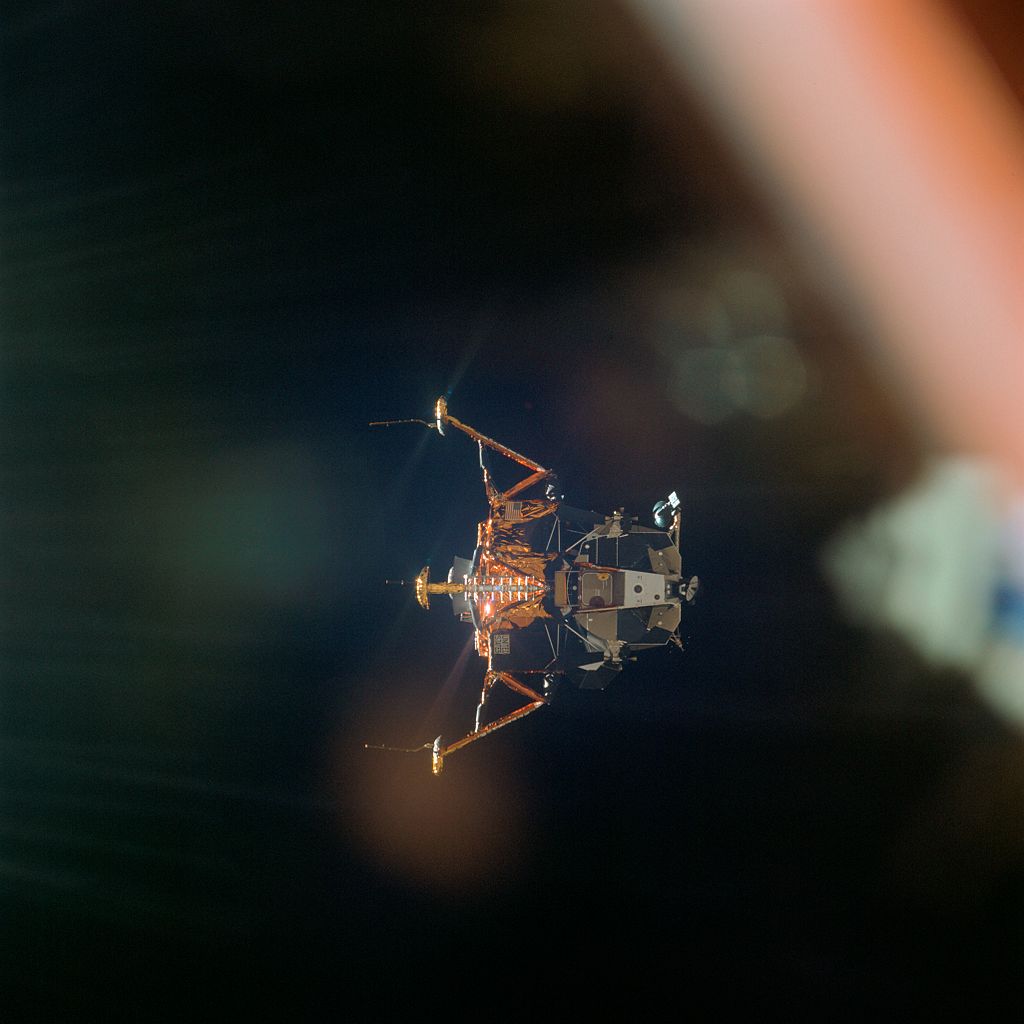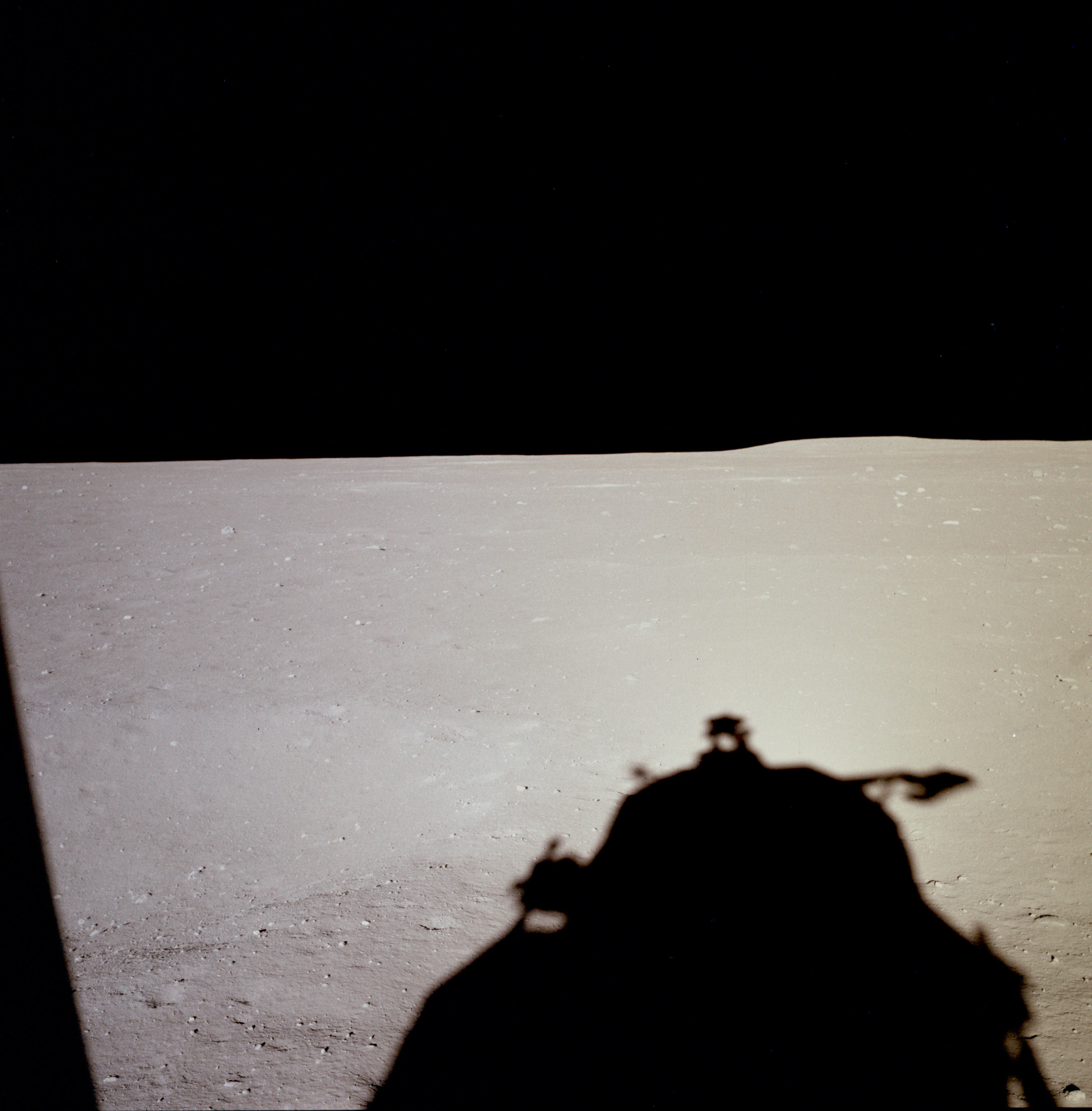
102:45:25 Aldrin: Four forward. Four forward. Drifting to the right a little. Twenty feet, down a half.
102:45:31 Duke: Thirty seconds (until the ‘Bingo’ call).
102:45:32 Aldrin: Drifting forward just a little bit; that’s good.
(Pause)
102:45:40 Aldrin: Contact Light.
102:45:43 Armstrong: Shutdown.
102:45:44 Aldrin: Okay. Engine Stop.
102:45:45 Aldrin: ACA out of Detent.
102:45:46 Armstrong: Out of Detent. Auto.
102:45:47 Aldrin: Mode Control, both Auto. Descent Engine Command Override, Off. Engine Arm, Off. Four-thirteen is in.
102:45:57 Duke: We copy you down, Eagle.
102:45:58 Armstrong: Engine arm is off. (Pause) Houston, Tranquility Base here. The Eagle has landed.

© 2018, Bryan R. Swopes
I just listened to CBS broadcast of landing on youtube. There were 26 seconds between the words “contact light” and Armstrong finishing his statement : The Eagle has landed. Your timeline shows only eight seconds. I imagine this is the timeline that NASA has on its website entitled Apollo 11 timeline. Thanks for your work on this and so many other aviation achievements and tragic accidents.
I am puzzled as to why you have no entries for the Mig-25 Foxbat time to climb records in 1973 and 31 August 1977. The plane was called Ye-155 in the 1973 record flights and the 1977 flights it was a more powerful version called the Ye-266M.
Thanks again. Enjoy the 48th Anniversary of the Apollo 11 Moon Landing.
Thank you, Thomas. You are correct: the info is from NASA’s timeline. Re: the Foxbat records. It is very difficult to gather information and photographs about aviation events from the Soviet era. So little is available on the Internet. My usual research practice is to use Google Translate to formulate my query into Russian (in Cyrillic), find something and then try to translate it back into English. This often doesn’t work out as well as I would hope. But I will keep trying. Thank you for visiting TDiA.
perhaps if Yefim Gordon is still writing he could assist you as I understand he is very knowledgeable on Soviet fighters in the 1950 to the 1990’s era. Also I was an avid reader of Aviation Week and Space Technology magazine in my teens and they had brief articles in 1973 on the Ye-155 records and then much coverage on the Streak Eagle in January 1975 and then a small 4 paragraph article in 1977 when the Ye-266M broke the Eagle’s three highest records on 31 August 1977. The first records were set on June 4, 1973 by the Ye-155. I believe from memory that AW&ST writer wrote that the Foxbat took back the 3 highest records while carrying 2000 pounds of ballast with “contempuous ease.”
Those Cold War days were something else. I also remember the media mania when the Belenko pilot flew his Foxbat to Japan in 1976.The Foxbat was not the super fighter it had been presented to the American public but it was a formidable aircraft that could perform its mission capably.
I believe the engines on the F-15E now produce the same 29000 pounds of thrust per engine as the engines on the Ye-266M did in 1977 during its record flights. The engines on the F-15E’s are more advanced and reliable and are low-bypass turbofans and are more fuel efficient than the rip-roaring turbojets of the MiG-25 and the prototype Ye-266M.
Thanks again for your site and your many hours of work.
I hope you are still working on it in 2019 and can have a series of posts as the July 16 to July 20 period marks the 50th anniversary of the Apollo 11 Moon Landing Triumph.
Thanks, Thomas. I’ll try to put some emphasis on my Foxbat records research.
His timeline shows 18 seconds until Armstrong STARTS that piece. So, maybe pretty accurate.
Thanks, George.
It is interesting that so many outlets have said that “Houston” was the first word spoken from the surface of the Moon but the lander was almost certainly on the surface when Buzz said “contact light”. I live a few minutes from the Johnson Space Center in Houston so there is a local interest in the incorrect statement, but it is clear that there were many words spoken from the surface before Neil said “Houston”.
One of my favorite Apollo 11 trivia questions I ask is: ‘What were the first words spoken from the Moon?’
‘Contact light’ is probably premature. If one examines the first photo in the post the contact probes can be seen on all the LEM footpads extending out about 5 feet. I don’t know what the settling rate was, ie could the LEM finish landing between the time Aldrin saw the contact light and announced it.
I would suggest the first words spoken from the Moon were the phrases ‘Shutdown’ and ‘Okay, Engine stop’. And as mentioned above more of the shut down check list follows before calling ‘Houston’.
Thanks, Steve. I’ll be rewatching the recent “Apollo 11” documentary later this evening, and will pay close attention to dialogue. 🙂
Brian;
With the caveat of account for for that damn VOX Mic lag, the stupid comm tone Lazio they needed to relay voice and data, and, well, analog recording and speed of light
😉
One thing that has always bothered me about the Moon landings is no flash light. On earth you can see the flash light’s beam due to the atmosphere. Now on the moon, there should be no flash light beam due to lack of atmosphere. So why did the astronauts not have flash lights. Thinking of NASA faking the Moon landings, that is why the astronauts don’t have flash lights. It would have been impossible to eliminate the beam.
Possibly batteries and the mission profiles:
Batteries in the 60’s, for the suits and the LEM would have been limited to lead-acid, dry chemical, and NiCad, or Nickel Cadmium
I can’t remember what they SPECIFICALLY used, I do remember NiCads were SOP for rechargeables, on the early sixties/seventies Air Force avionics I worked on, with alkaline as the only other option, except for lead acid in aircraft
The mission profiles, as I remember, specified sunlight for landings, to avoid needing lights
It comes down to power, and what you can carry
Sigh …
All missions were conducted during lunar daylight conditions with solar elevations ranging between 10 and 50 degrees above the horizon. There was ample illumination as can be observed in the photographs. Supplemental lighting was not necessary as the mission design placed limits to ensure ample illumination to achieve mission objectives . This constraint was just one of many that restricted/ defined the launch windows.
In addition, a flashlight would be a poor design solution as it would be an extra piece of equipment to be carrying. Adjustable helmet mounted lights would be superior, more along the lines of the current EMU suits in use today.
I believe during one of the later missions some was looking down into a crater and commented on the darkness in the shadows. However they were not planning to operate in the shadows during Apollo. The focus for Artemis missions has been directed toward the South Pole. Operating in that region will probably require supplemental lighting for use in shadows.
Respectfully, I suspect on Earth, during cloudless daylight hours, you would not find a need for a flashlight either.
Thank you, Steve.